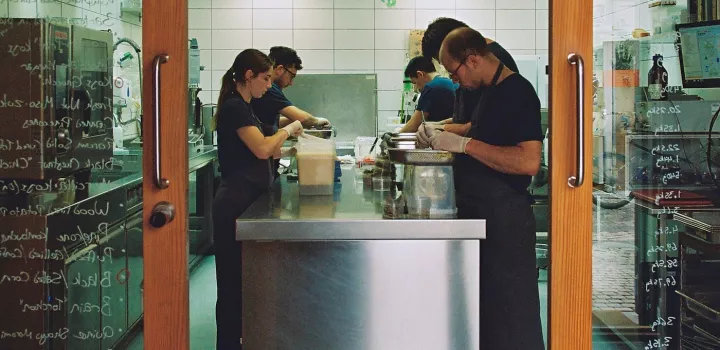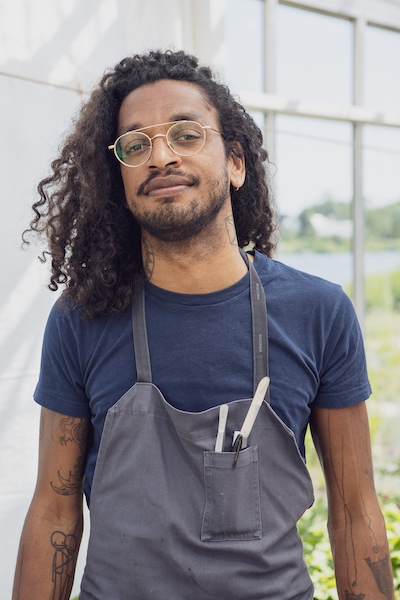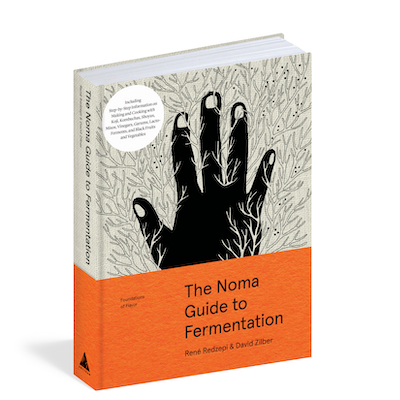
David Zilber Divulges what it's like to Direct the Noma Fermentation Lab
Excerpts from our exclusive interview on Instagram Live.
"In gastronomy, there are these corners of the world that have yet to be filled in and that’s how I see our job." — Chef David Zilber describes his culinary career directing the Noma Fermentation Lab.
"We're basically a team of four or five people that are left to our devices to just innovate in this one field and deal with other special projects that come our way and, of course, write books and do media and stuff like that, but that gives Noma a veritable pantheon of things to choose from that always keeps the menu exciting whenever we’re creating new dishes," David says to sum up his work in the fermentation lab at Copenhagen restaurant Noma, No. 2 on the 2019 World's 50 Best Restaurants list.
Here are a few highlights from our conversation about his career leading to the prominent position, his research and development work, and the world of modern fermentation.

I imagine you didn’t start lacto-fermenting in a shed in your youth. How did this all come about in terms of your career trajectory?
It’s funny because it was almost six years ago to this day that I got the job at Noma. That was back in 2014, which feels like yesterday. I started at a really young age, I was 18-years-old — bad grades in high school, didn’t apply myself, wasn’t going to get into university. I was fortunate enough to have a good guidance counselor who was like, “You know what? I think you need something hands-on in your life.” So I became a chef.
She put me into an apprenticeship program, went to a local journeyman's college in Toronto for a month, and then was put into kitchens on apprenticeship and just kept doing that. I never went back to school to finish my diploma. I just kept cooking, kept looking for better and better restaurants up until the point that I was a sous chef at Canada’s best restaurant. That was in Vancouver, a place called Hawksworth, that’s still around today. I put in my time there and decided I needed to hop the pond and look for bigger fish.
So I landed at Noma, wrote them a long cover letter and parlayed my passion, and after a short trial in 2014, they hired me on. I just started in the kitchen, I was bottom of the wrung, everyone has to cut their teeth there. No one comes in on top. Everyone gets shit. Everyone has to learn the ropes. So that’s what I did on the cold station upstairs doing way more mise en place than I was able to, trying to manage three interns that were changed up every day, just trying to get set for lunch and dinner service.
It was a grind, like 18-hour days, but about a year into keeping my head above water in the restaurant — Dan Justi was the head chef at the time, great guy, now has Brigade. I got sat down one day after service. I thought I was going to get a scolding, but Dan said, "Hey, René [Redzepi] and Lars [Williams] and Arielle [Johnson] want you to move over to the lab to look over production and basically be a sous chef over there." I thought it was a once-in-a-lifetime opportunity, I knew it came with a bit of a commitment, but I said, you know, let’s dive in.
I was kind of hand-picked out of the kitchen. I hadn’t really had any explicit interest in fermentation before that, but they kind of knew me as the science-y guy in the kitchen. I’m a voracious reader, just self-education, and that paid off. Curiosity kills some cats and then rewards some others.
Fermentation encompasses so many issues (sustainability, locality, foraging, farmers, markets, health and the microbiome, the impact on the global footprint). How do you feel that the work you’ve done at Noma is growing amongst these issues?
Noma was not responsible for the fermentation revivalism that we started seeing in the early 2000s and late 1990s. People like Sandor Katz, lots of makers and fermenters, just grassroots people, even people like the guys at GT Kombucha, were responsible for building this slow burn of gathering people’s awareness that there was a world beyond beer, wine, spirits and cheese. Not that anyone thinks of those as fermented in their day-to-day lives.
But Noma ran with that. There were definitely people that came before me in the test kitchen, whether that’s Torsten Vildgaard, Lars Williams, Søren Westh or Thomas Frebel, there are myriad chefs who put their input into Noma’s history and guided the trajectory that, now since it’s this big, shiny lab that’s the essential core of Noma’s R&D and innovation, but I will say that in a lot of ways Noma through its history and René have been in the right place at the right time kind of knocking on the right doors, making opportunities for themselves, and I don’t think that there was another restaurant with as much prominence that was as interested into fermentation genuinely and as interested in the investigation into this realm as we were six years ago when I started, 8-10 years ago when those first investigations first took place.

To that effect, if we have people’s attention then we want to do the best we can with it, and that was absolutely René’s impetus for teaming up with Artisan to publish the last book, which was a very different cookbook than the two that came before it. Not a beautiful coffee table cookbook with dishes that you never eat, but something that would actually teach people principles of how to make these things accessible and put them within arm’s reach or at least within understanding.
Even going to the grocery store and picking up a standard Kikkoman soy sauce off the shelf has a different meaning when you understand, oh, I can use this to add umami to anything not just Asian food. If I add just a tablespoon of soy sauce to a bolognese, it’s going to taste better. No one’s going to think that my bolognese tastes “Asian.” When you make the connection that if there’s umami that’s made my lactic acid bacteria in Parmesan cheese and I grate that over my pasta anyway then anywhere I want to seek out umami it will make sense in that same dish.
It’s about drawing those connections and making those constellations in people’s gastronomic mindsets. And it does take a while to cozy up to being comfortable cooking with these things in the kitchen. We still want the world to feel more at ease with fermentation, not think of germs as all as evil as COVID-19. There are far more that benefit us than harm us, viruses not included.
There is something serendipitous about Noma being at the forefront or being a restaurant that champions this practice and the ongoing scientific discoveries that are proving that fermentation and the microbes that are responsible for it and the microbes we live alongside on a regular basis, on and inside of us, have a much greater impact on our health and well-being, our homeostasis, the maintenance of our human organism.
There’s a word that I love that comes up in most of the readings about microbes and fermentation and that’s one of the “holobiont:” not just an organism like my genetic code and everything that makes a human body, but my genetic code and everything that lives on me and keeps me healthy as a working ecosystem that lives on my skin, in my mouth, in my gut, in my butt, in my armpits, in my food, in the fields of the farmers that provide me with that food. There is this greater ecosystem and fermentation is a great bridge to understanding that.
How do you figure out where you want to go in terms of your research?
It’s very much about filling out a whiteboard we have in the lab and thinking about, as crazy as it sounds, all the things we haven’t thought of. It’s not enough to say should we revisit this miso and try it with buckwheat koji? To the test kitchen, whether it’s a new project or not, the buckwheat miso will be completely equivalent to the barley miso that we made for them that they’re already comfortable using, that they already have built-in recipes for, that they don’t need to adjust or think about dietary restrictions for. There’s an equivalency. If we were stocking a grocery store shelf we could come up with new products that kind of felt the same but were different every month like a book club.
At Noma you have infinite possibility and you have to find the best possible thing.
In the restaurant, to serve the test kitchen’s needs, we have to come up with things that are completely out of left field. We have to look under rocks that people didn’t even know were buried under mountains they’ve never heard of to find the really, really new shit that’s actually going to provide a new flavor in ways that they haven’t seen before. It’s not enough to keep hacking away at iterations [that aren’t] a clear enough differentiation to be a completely new and novel thing that’s going to wow René and make his hair stand up and say okay, this needs to be the focus of an entire marinade or of x,y and z. We do spend a lot of time really digging down some deep, dark rabbit holes to try and find things that either people haven’t done, to find recipes or microbes that have been forgotten about or ways of combining technology and fermentation to make things that are legitimately new and really do push the boundaries.
What is your biggest challenge despite all your resources?
Some days it’s keeping that childlike wonder, and that is a part of me innately. I can’t get enough of educational videos on YouTube ... but with fermentation sometimes when you haven’t impressed anyone in a really long time, it might be a month or two when you’re doing your job, you’re making new things. You taste something and you’re like, this is good but it’s not special, special. You’re kind of banging your head against a wall. Sometimes it’s hard to hold on to that spark where, when I first started in the lab with Lars and Ariel and every little yogurt pod and vial or beaker that I tasted was a mindblowing new world to me. You have to sit yourself down and take a deep breath and say okay, well there’s still work to be done, and even though the returns might be coming in slower, this is just part of the job.
Watch the full interview on IGTV and learn more about pursuing a culinary career at ICE.
Read more about fermentation:
Fermentation: A Framework for Culinary Discovery
Fermentation Experimentation: Principles Behind Fermentation
Experimenting with Koji in the Culinary Technology Lab


Add new comment